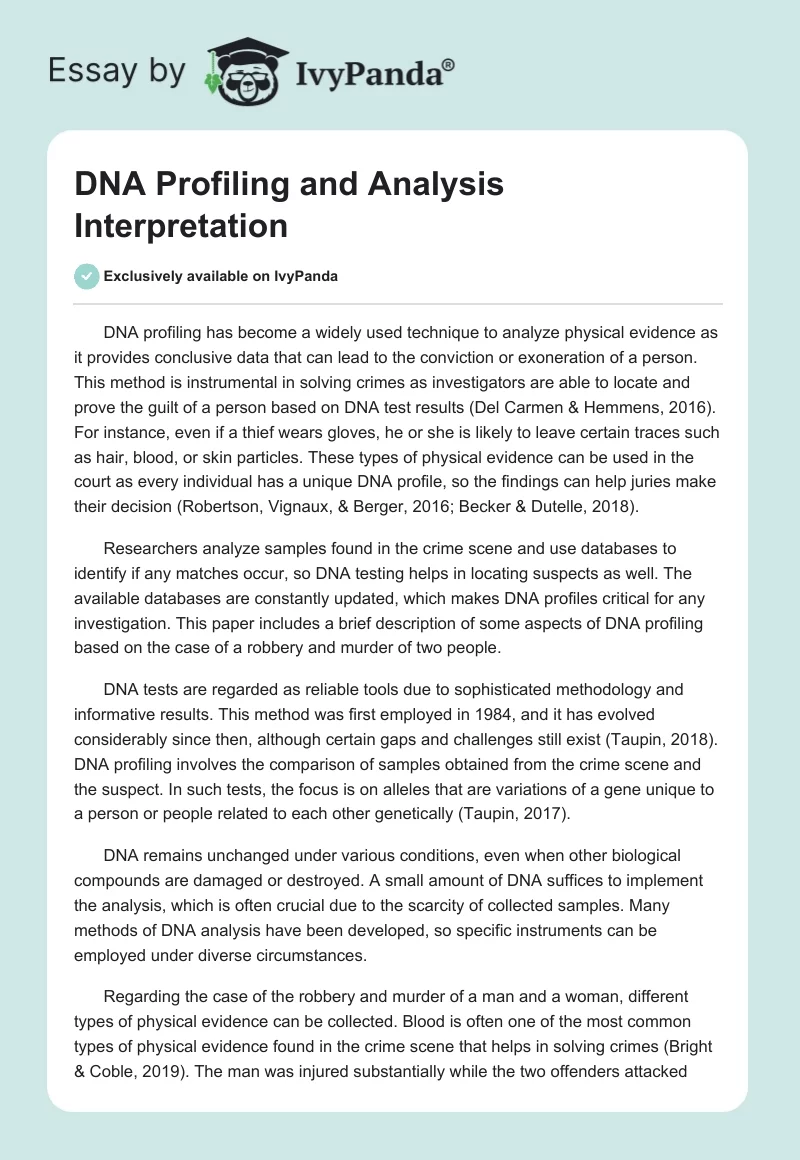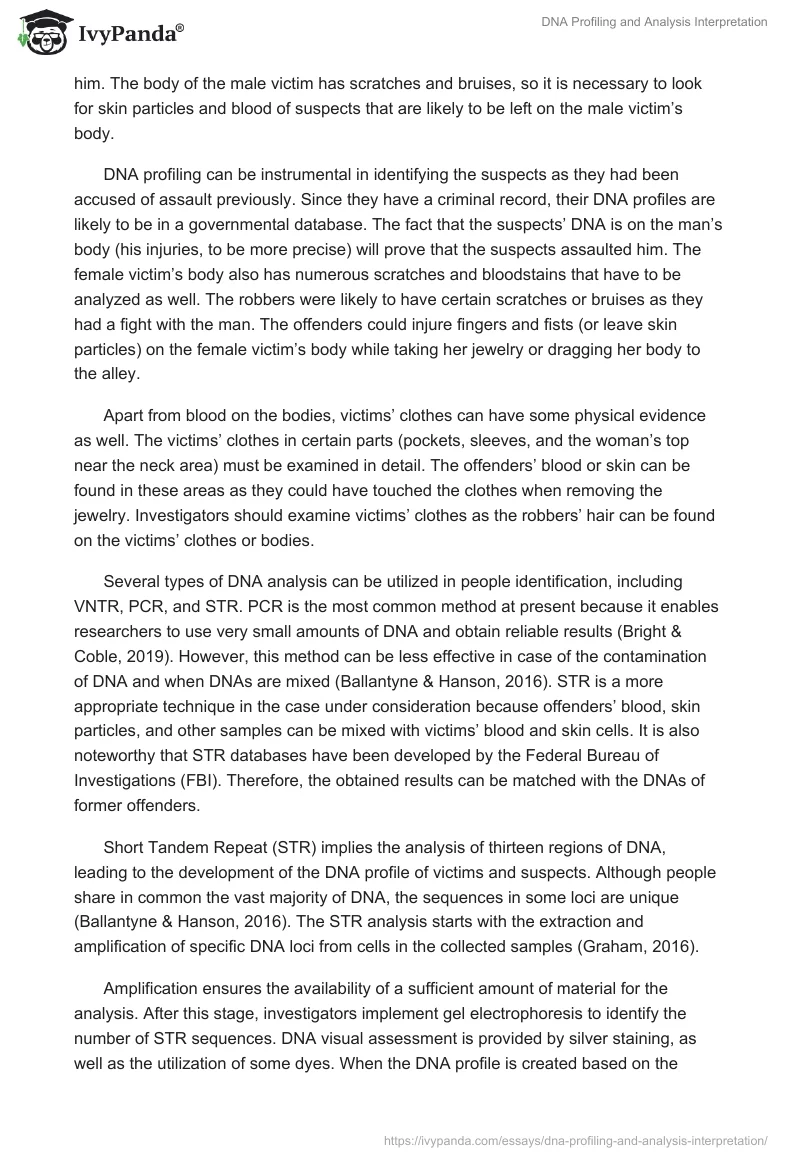DNA profiling has become a widely used technique to analyze physical evidence as it provides conclusive data that can lead to the conviction or exoneration of a person. This method is instrumental in solving crimes as investigators are able to locate and prove the guilt of a person based on DNA test results (Del Carmen & Hemmens, 2016). For instance, even if a thief wears gloves, he or she is likely to leave certain traces such as hair, blood, or skin particles. These types of physical evidence can be used in the court as every individual has a unique DNA profile, so the findings can help juries make their decision (Robertson, Vignaux, & Berger, 2016; Becker & Dutelle, 2018).
Researchers analyze samples found in the crime scene and use databases to identify if any matches occur, so DNA testing helps in locating suspects as well. The available databases are constantly updated, which makes DNA profiles critical for any investigation. This paper includes a brief description of some aspects of DNA profiling based on the case of a robbery and murder of two people.
DNA tests are regarded as reliable tools due to sophisticated methodology and informative results. This method was first employed in 1984, and it has evolved considerably since then, although certain gaps and challenges still exist (Taupin, 2018). DNA profiling involves the comparison of samples obtained from the crime scene and the suspect. In such tests, the focus is on alleles that are variations of a gene unique to a person or people related to each other genetically (Taupin, 2017).
DNA remains unchanged under various conditions, even when other biological compounds are damaged or destroyed. A small amount of DNA suffices to implement the analysis, which is often crucial due to the scarcity of collected samples. Many methods of DNA analysis have been developed, so specific instruments can be employed under diverse circumstances.
Regarding the case of the robbery and murder of a man and a woman, different types of physical evidence can be collected. Blood is often one of the most common types of physical evidence found in the crime scene that helps in solving crimes (Bright & Coble, 2019). The man was injured substantially while the two offenders attacked him. The body of the male victim has scratches and bruises, so it is necessary to look for skin particles and blood of suspects that are likely to be left on the male victim’s body.
DNA profiling can be instrumental in identifying the suspects as they had been accused of assault previously. Since they have a criminal record, their DNA profiles are likely to be in a governmental database. The fact that the suspects’ DNA is on the man’s body (his injuries, to be more precise) will prove that the suspects assaulted him. The female victim’s body also has numerous scratches and bloodstains that have to be analyzed as well. The robbers were likely to have certain scratches or bruises as they had a fight with the man. The offenders could injure fingers and fists (or leave skin particles) on the female victim’s body while taking her jewelry or dragging her body to the alley.
Apart from blood on the bodies, victims’ clothes can have some physical evidence as well. The victims’ clothes in certain parts (pockets, sleeves, and the woman’s top near the neck area) must be examined in detail. The offenders’ blood or skin can be found in these areas as they could have touched the clothes when removing the jewelry. Investigators should examine victims’ clothes as the robbers’ hair can be found on the victims’ clothes or bodies.
Several types of DNA analysis can be utilized in people identification, including VNTR, PCR, and STR. PCR is the most common method at present because it enables researchers to use very small amounts of DNA and obtain reliable results (Bright & Coble, 2019). However, this method can be less effective in case of the contamination of DNA and when DNAs are mixed (Ballantyne & Hanson, 2016). STR is a more appropriate technique in the case under consideration because offenders’ blood, skin particles, and other samples can be mixed with victims’ blood and skin cells. It is also noteworthy that STR databases have been developed by the Federal Bureau of Investigations (FBI). Therefore, the obtained results can be matched with the DNAs of former offenders.
Short Tandem Repeat (STR) implies the analysis of thirteen regions of DNA, leading to the development of the DNA profile of victims and suspects. Although people share in common the vast majority of DNA, the sequences in some loci are unique (Ballantyne & Hanson, 2016). The STR analysis starts with the extraction and amplification of specific DNA loci from cells in the collected samples (Graham, 2016).
Amplification ensures the availability of a sufficient amount of material for the analysis. After this stage, investigators implement gel electrophoresis to identify the number of STR sequences. DNA visual assessment is provided by silver staining, as well as the utilization of some dyes. When the DNA profile is created based on the obtained data, it is compared with the profile of the suspect. Alternatively, DNA databases are reviewed to discover matches and identify the suspect or suspects. The STR analysis can be employed when performing DNA testing of all the collected samples in the case under study. However, this technique will be the most appropriate for the examination of blood and skin cells.
The collected evidence was instrumental in convicting the suspects as their guilt was proved. The fact that their DNA was found on victims’ bodies suggests that the people were in contact. The suspects and the victims had not been acquainted previously, so it becomes clear that suspects assaulted the victims. It is noteworthy that the mentioned evidence could hardly suffice to prove that the convicted killed the victims.
Other types of evidence (for example, ballistic) were needed to prove this. It is also noteworthy that the primary value of the evidence mentioned above is associated with the opportunity to locate suspects. Nevertheless, DNA profiling contributed to convicting the suspects in court.
In conclusion, it is possible to state that DNA testing is an effective instrument employed in forensic science. The identification of suspects’ DNA profiles and the provision of evidence in the court are major outcomes of DNA tests. Several types of DNA profiling exist, but STR is a preferable method in certain cases. For instance, the case of the robbery and murder of two people illustrates the benefits of this technique. Contaminated DNA, mixed DNA, and small amounts of DNA can pose certain challenges when other DNA testing instruments are employed. STR analysis effectively addresses these obstacles, which makes it a preferable strategy in cases similar to the one under analysis.
References
Ballantyne, J., & Hanson, E. K. (2016). Y-chromosome short tandem repeats. In A. Jamieson & S. Bader (Eds.), A guide to forensic DNA profiling (pp. 149-154). Chichester, England: John Wiley & Sons.
Becker, R. F., & Dutelle, A. W. (2018). Criminal investigation. Boca Raton, FL: CRC Press.
Bright, J. A., & Coble, M. (2019). Forensic DNA profiling: A practical guide to assigning likelihood ratios. Burlington, MA: Jones & Bartlett Learning.
Del Carmen, R. V., & Hemmens, C. (2016). Criminal procedure: Law and practice (10th ed.). Boston, MA: Cengage Learning.
Graham, E. A. M. (2016). DNA: An overview. In A. Jamieson & S. Bader (Eds.), A guide to forensic DNA profiling (pp. 9-28). Chichester, England: John Wiley & Sons.
Robertson, B., Vignaux, G. A., & Berger, C. E. H. (2016). Interpreting evidence: Evaluating forensic science in the courtroom (2nd ed.). Oxford, England: John Wiley & Sons.
Taupin, J. M. (2017). Introduction to forensic DNA evidence for criminal justice professionals. Boca Raton, FL: CRC Press.
Taupin, J. M. (2018). Using forensic DNA evidence at trial: A case study approach. Boca Raton, FL: CRC Press.


